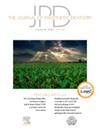Influence of splinting scan bodies or incorporating three-dimensionally printed scan aids on the trueness of complete arch digital scans
IF 4.3
2区 医学
Q1 DENTISTRY, ORAL SURGERY & MEDICINE
引用次数: 0
Abstract
Statement of problem
Studies are sparse on how splinting scan bodies or incorporating 3-dimensionally (3D) printed scan aids influence the trueness of complete arch digital scans.
Purpose
The purpose of this in vitro study was to compare the trueness of multisite implant recordings obtained using 6 different methods on an edentulous mandible.
Material and methods
A definitive cast of an edentulous mandible with 4 multi-unit analogs placed at different angles and interanalog distances was extraorally scanned, and the resulting data were saved as a reference file. To obtain experimental files, 6 distinct methods were used: conventional impression with splinted open-tray impression copings (IC), intraoral scanning (IOS) without splinting scan bodies or using any scan aids (SB), IOS with pattern resin-splinted scan bodies (PR), IOS with composite resin-splinted scan bodies (CR), IOS with 3D printed custom scan bodies (CSB), and IOS with 3D printed auxiliary apparatus (AA). The experimental files were aligned to the reference file in a metrology software program. The 3D comparison algorithm was run to quantify the root mean square estimate error (RMS). Scan bodies in the files were converted to hollow virtual cylinders, and the Cartesian coordinates of the lines passing through the centers of these cylinders were recorded to analyze angular (AD) and linear distortion (LD). LD was further analyzed along the x (∆X), y (∆Y), and z axes (∆Z). One-way ANOVAs with the Tukey HSD test were used for statistical analysis (α=.05).
Results
AD at all sites, LD at all sites, and the RMS error showed significant differences (P<.05). The IC group showed the lowest AD values across all sites, followed by the AA, CSB, PR, CR, and SB groups. The SB group had the greatest LD values at all sites, while the IC group indicated the lowest LD values at all sites except the left anterior site. In terms of 3D distortions, the SB group had the largest RMS value, whereas the IC group showed the lowest RMS value. ∆X, ∆Y, and ∆Z values also showed significant differences at all sites (P<.001) except for the ∆Z values at the right anterior site (P=.194). The highest mean ∆X, ∆Y, and ∆Z values were recorded in the SB group except for the ∆Z measurement of the left posterior site.
Conclusions
The IC group outperformed the other groups. The AA group exhibited distortion comparable with that of the IC group. Splinting scan bodies or using scan aids enhanced the trueness.
夹板扫描体或结合三维打印扫描辅助工具对完整牙弓数字扫描真实性的影响。
问题陈述:关于夹板扫描体或结合三维打印扫描辅助工具如何影响全牙弓数字化扫描的真实度的研究很少。目的:本体外研究的目的是比较在无牙颌上使用6种不同方法获得的多位点种植体记录的真实度:体外扫描无牙下颌骨的确定性铸模,在铸模上以不同的角度和模拟间距放置 4 个多单位模拟体,并将所得数据保存为参考文件。为了获得实验文件,使用了 6 种不同的方法:使用夹板开托印模托具的传统印模(IC)、不夹板扫描体或不使用任何扫描辅助工具的口内扫描(IOS)(SB)、使用模式树脂夹板扫描体的 IOS(PR)、使用复合树脂夹板扫描体的 IOS(CR)、使用 3D 打印定制扫描体的 IOS(CSB)以及使用 3D 打印辅助设备的 IOS(AA)。实验文件在计量软件程序中与参考文件对齐。运行三维比较算法来量化均方根估计误差(RMS)。将文件中的扫描体转换为空心虚拟圆柱体,并记录通过这些圆柱体中心的直线的笛卡尔坐标,以分析角度(AD)和线性失真(LD)。LD 沿 x 轴(∆X)、y 轴(∆Y)和 z 轴(∆Z)进一步分析。统计分析采用单因素方差分析和 Tukey HSD 检验(α=.05):结果:所有部位的 AD、所有部位的 LD 和均方根误差均显示出显著差异(PC结论:IC 组的表现优于其他组。AA 组的失真与 IC 组相当。夹紧扫描体或使用扫描辅助工具可提高真实度。
本文章由计算机程序翻译,如有差异,请以英文原文为准。
求助全文
约1分钟内获得全文
求助全文
来源期刊

Journal of Prosthetic Dentistry
医学-牙科与口腔外科
CiteScore
7.00
自引率
13.00%
发文量
599
审稿时长
69 days
期刊介绍:
The Journal of Prosthetic Dentistry is the leading professional journal devoted exclusively to prosthetic and restorative dentistry. The Journal is the official publication for 24 leading U.S. international prosthodontic organizations. The monthly publication features timely, original peer-reviewed articles on the newest techniques, dental materials, and research findings. The Journal serves prosthodontists and dentists in advanced practice, and features color photos that illustrate many step-by-step procedures. The Journal of Prosthetic Dentistry is included in Index Medicus and CINAHL.
 求助内容:
求助内容: 应助结果提醒方式:
应助结果提醒方式:


